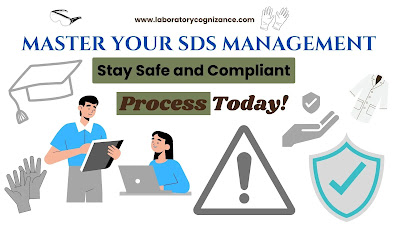“Efficient SDS Management: Best Practices and Tools for Safety Data Sheet Compliance”

Introduction
SDS (Safety Data Sheet) management is an essential aspect of ensuring workplace safety & compliance. It is crucial to understand the importance of SDS management & the steps to take to ensure compliance. In this article, we will provide seven important things you should know about SDS management.

Understanding SDS Management
Safety Data Sheets (SDS) are documentation that details the properties & risks associated with chemicals in the workplace. The product identifier, first-aid instructions, handling & storage instructions, exposure controls & personal protection instructions, physical and chemical properties, stability & reactivity instructions, toxicological info, ecological information, disposal concerns, transport instructions, and regulatory information are all included in the SDS.
SDS management involves the proper storage, maintenance, and updating of these documents to ensure that they are readily accessible to workers & relevant parties, such as emergency responders. Failure to manage SDSs correctly can result in non-compliance with regulations, worker exposure to hazards, and increased liability for the organization.

Seven Things to Know About SDS Management
- SDSs must be readily accessible to workers:
SDSs must be readily accessible to workers who handle or work with hazardous chemicals. This requirement means that SDSs must be available in a location that is easily accessible & that workers can access at any time.
- SDSs must be updated regularly:
SDSs must be updated regularly to reflect any changes to the chemical product’s composition or hazard information. It is essential to ensure that the SDSs are up to date to provide accurate information to workers & emergency responders.
- SDSs must be available in the appropriate language:
If your organization employs non-English speaking workers, you must provide SDSs in a language they understand. Providing SDSs in the appropriate language is necessary to ensure that workers understand the hazards associated with the chemicals they are handling.
- SDS management software can streamline the process:
SDS management software can help organizations streamline the SDS management process, reduce errors, and ensure compliance. This software can also provide access to SDSs across multiple locations & simplify the updating process.
- SDS management requires proper training:
Proper training is essential to ensure that workers understand how to access SDSs, interpret the information, and respond appropriately to any hazards. Organizations must provide training to workers on SDS management to ensure compliance & workplace safety.
- SDS management is subject to regulatory requirements:
SDS management is subject to regulatory requirements that vary by jurisdiction. Organizations must understand and comply with the applicable regulatory requirements to avoid penalties & legal liabilities.
- SDS management is essential for emergency response:
SDSs are critical documents for emergency responders in the event of an accident or incident involving hazardous chemicals. Emergency responders rely on SDSs to understand the chemical hazards involved & respond appropriately to protect themselves & the public.

Conclusion
A crucial component of occupational safety and compliance is SDS management. SDSs must be properly maintained, updated, and stored in order for workers and first responders to have easy access to them. Correct SDS management can prevent non-compliance, expose workers to risks, and enhance the organization’s liability. Organizations may guarantee compliance, a safe work environment, and environmental protection by understanding the significance of SDS management & adhering to best practices.


1 thought on “Efficient SDS Management: Best Practices and Tools for Safety Data Sheet Compliance”